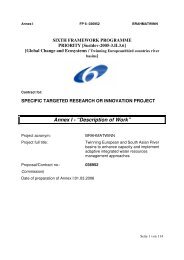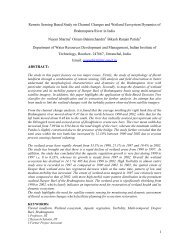WP 5 Analysis of present IWRM practices - Brahmatwinn
WP 5 Analysis of present IWRM practices - Brahmatwinn
WP 5 Analysis of present IWRM practices - Brahmatwinn
You also want an ePaper? Increase the reach of your titles
YUMPU automatically turns print PDFs into web optimized ePapers that Google loves.
the output <strong>of</strong> the main industry branches. Using estimation method suggested by TAR Hydrology<br />
Bureau, the average water consumption <strong>of</strong> water per 10,000 Yuan industrial output is at the level <strong>of</strong><br />
400 m 3 yearly and the total amount consumption was about 86.84 million m 3 in TAR in 2006.<br />
There are four types <strong>of</strong> enterprises that consume a great lot <strong>of</strong> water and produce a lot <strong>of</strong> waste<br />
water. They are power plant, mining and dressing plants, cement plants and Beer Company:<br />
• Power Plant<br />
There were 107 enterprises <strong>of</strong> production and supply <strong>of</strong> electricity and thermal power in 2006. It is<br />
the largest industry sector in TAR. These enterprises generated 1515. 1 million Kwh <strong>of</strong> electricity and<br />
91 percent <strong>of</strong> electricity was generated by hydropower and about 5 percent (70 million Kwh) was<br />
generated by thermal power plant in 2006. The amount <strong>of</strong> water consumption by thermal power<br />
plant estimated (water consumption amount <strong>of</strong> per kwh = 3.36 kg) was 0.2352 million m 3.<br />
• Mining and Dressing Plant<br />
There were 71 unit enterprises <strong>of</strong> mining and dressing in 2006 and main mining production are<br />
chromium ore and borax ore but the output <strong>of</strong> borax has decreased significantly since 2000 for borax<br />
plants in China demanded little TAR natural borax. The output <strong>of</strong> chromium was 0.1217 million ton.<br />
The amount <strong>of</strong> water consumption estimated (water consumption amount <strong>of</strong> per ton <strong>of</strong> output <strong>of</strong><br />
chromium ore = 6 ton) was 0.7306 million m 3 .<br />
• Cement Plant<br />
The output <strong>of</strong> cement reached 1.666 million tons in TAR in 2006, and the most <strong>of</strong> the cement<br />
products in TAR is produced by local plants. The amount <strong>of</strong> water consumption estimated (water<br />
consumption amount <strong>of</strong> per ton <strong>of</strong> output <strong>of</strong> cement = 0.2 ton) was 0.332 million m 3 .<br />
• Beer Plant<br />
The output <strong>of</strong> beer was 63,280 tons in 2006 and reached 83,500 tons in 2007, a rise <strong>of</strong> 31.9 percent.<br />
The amount <strong>of</strong> water consumption estimated (water consumption amount <strong>of</strong> per ton <strong>of</strong> output <strong>of</strong><br />
beer = 10 ton) was 0.835 million m 3 .<br />
Water quality in Brahmaputra river basin in TAR<br />
The evaluation <strong>of</strong> the Brahmaputra river basin water quality in Tibet is generally good, man-made<br />
pollution is not prominent. Water quality in Brahmaputra River Basin depends on the geographical<br />
location (upper, middle or lower reaches in Tibet), location <strong>of</strong> land mines, and landforms. Water<br />
quality in dry season is better than that in rain season for sediment carried an amount <strong>of</strong> lead and<br />
cadmium in rain season. However, in the sites where water was polluted by thermal power plant<br />
sewage, like Yangbajing section <strong>of</strong> Doilung Qu River, water quality in rain season was better than that<br />
in dry season. For example, in 2000 and 2001, water quality in a length <strong>of</strong> 2883 km <strong>of</strong> river in<br />
Brahmaputra, including the main stream <strong>of</strong> the Brahmaputra and three first- level tributary, Nianchu<br />
River, the Lhasa River, and Niyang and two second-level tributary, Doilung Qu and Pasang Qu river<br />
were evaluated. In dry season, water quality in more than 97.4 percent <strong>of</strong> monitored river was better<br />
than level Ⅲ (slightly polluted), 0.1 percent at level Ⅲ and 2.5 percent lower than level Ⅲ. In rain<br />
season, water quality in more than 76.8 percent <strong>of</strong> monitored river was better than level Ⅲ (slightly<br />
polluted) and 23.2 percent lower than level Ⅲ.<br />
A more detailed overview is given in the Tab. 7: River water quality and waste water discharge<br />
monitoring in TAR from 2000 to 2007.<br />
18





